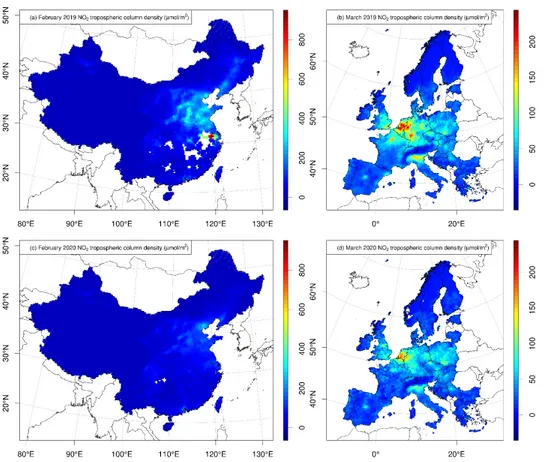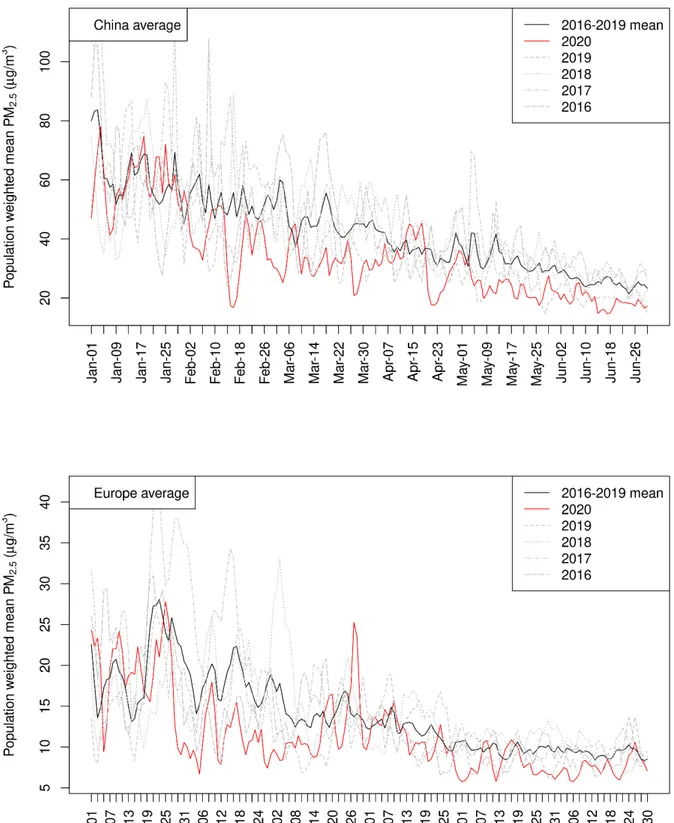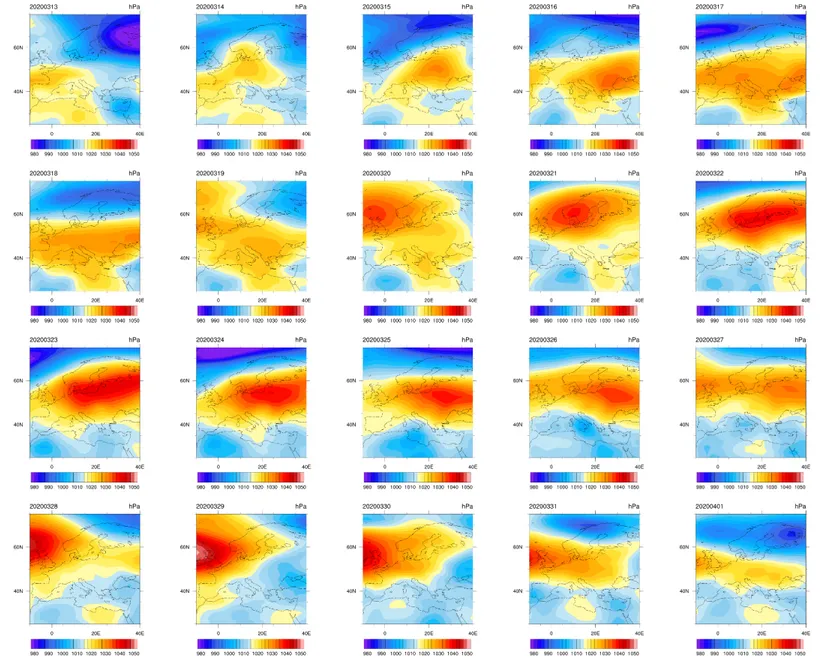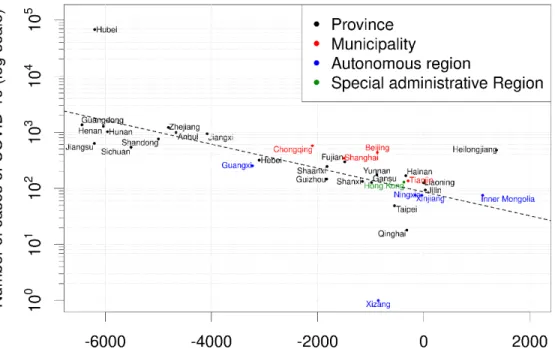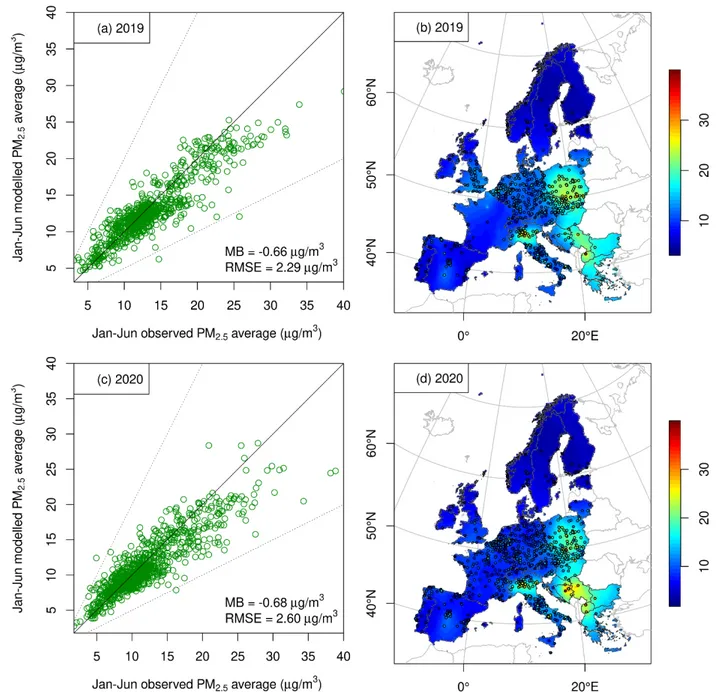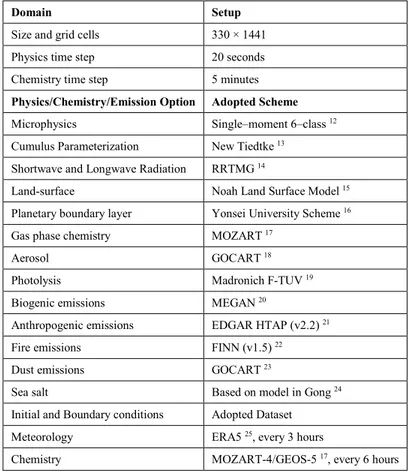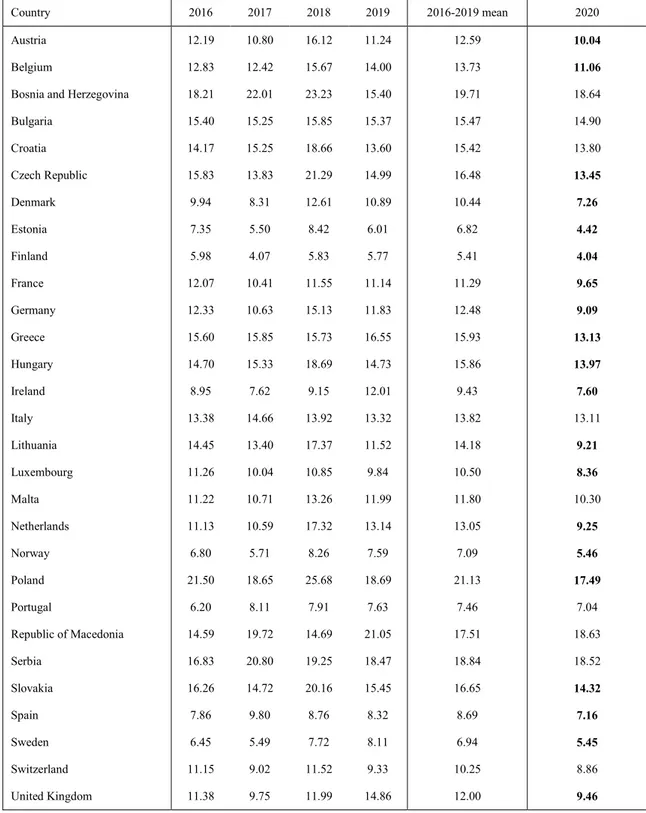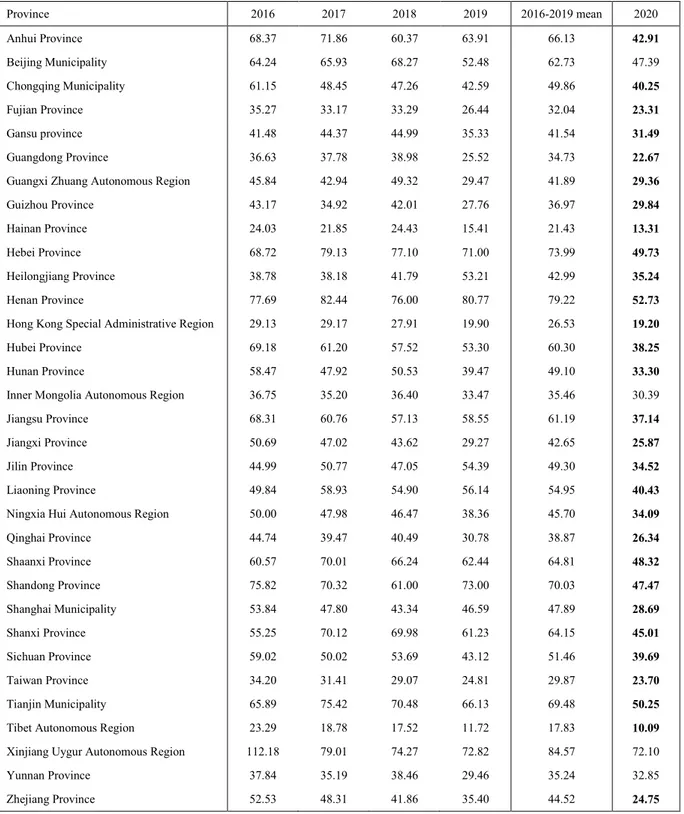Supplementary appendix
This appendix formed part of the original submission and has been peer reviewed.
We post it as supplied by the authors.
Supplement to: Giani P, Castruccio S, Anav A, Howard D, Hu W, Crippa P. Short-term
and long-term health impacts of air pollution reductions from COVID-19 lockdowns
in China and Europe: a modelling study. Lancet Planet Health 2020; published online
Sept 22. http://dx.doi.org/10.1016/S2542-5196(20)30224-2.
1
Appendix to manuscript
Short- and long-term health impacts of air pollution reductions from COVID-19 lockdowns
in China and Europe
Paolo Giani
1, Stefano Castruccio
2, Alessandro Anav
3, Don Howard
4, Wenjing Hu
2, Paola
Crippa
1*1Department of Civil and Environmental Engineering and Earth Sciences, University of Notre Dame, Notre Dame,
IN, USA
2Department of Applied and Computational Mathematics and Statistics, University of Notre Dame, Notre Dame, IN,
USA
3Climate Modeling Laboratory, ENEA, Italian National Agency for New Technologies, Energy and Sustainable
Economic Development, CR Casaccia, Santa Maria di Galeria, Italy
4Department of Philosophy, University of Notre Dame, Notre Dame, IN, USA
*Corresponding author: Paola Crippa, Department of Civil and Environmental Engineering and Earth Sciences,
2
EVIDENCE OF IMPROVED AIR QUALITYThe air quality index (AQI) for both China and Europe showed an overall improvement during the first quarter of 2020 as a response to the wide range of interventions implemented by national governments to contain the spread of COVID-19. In China, during the first 30 days following the shutdown (January 29 to February 29), 46% of the monitoring stations indicated a good to excellent air quality (AQI<=50) against 34% in the same period in 2019. For heavily to severely polluted air quality (AQI>100) during the same days, in 2020 only 2% of the stations indicated it against 7% in 2019. In some main cities in Europe, ground observations in the week of 16th-22th March highlighted a
sharp decrease, between 20% and 60%, of nitrogen dioxide (NO2) concentrations against the same week in 20191,2.
Similar conclusions can be drawn from satellite observations3 which show a significant decrease in NO2 concentrations
in February and March as a result of the lockdown of most of the anthropogenic activities (Figure S1).
We analyze the differences between PM2.5 concentrations during post-outbreak period and the same period from
several previous years (2016-2019), to gain insights on the drivers of the air quality changes observed after COVID-19 outbreak. Even though interannual meteorological fluctuations can considerably affect PM2.5 concentrations4,5, the
observed decrease in PM2.5 throughout China cannot be ascribed to meteorological variations alone (Figure S2, Table
S4 and Table S7). The population-weighted mean PM2.5 during February-March 2020 is statistically lower than the
natural meteorological variability, as suggested by the p-values obtained by pairing 2020 concentrations with the same period in previous years (<<0.001, Table S7). This pattern is even more evident for Hubei province and other provinces highly impacted by lockdown measures (e.g. Zhejiang, Guangxi, Shaanxi, Henan, Shandong, Table S4). In Europe, the meteorological fluctuations play a more significant role in influencing 2020 concentrations. Although
population-weighted mean PM2.5 during the lockdown period (21 February-17 May) is also considerably lower than 2016-2019,
the statistical significance is weaker (Table S6). Exceptionally low PM2.5 concentrations have been observed during
the second half of February and the beginning of March, whereas PM2.5 accumulated in most of central Europe toward
the end of March (Figure S3) because of westward transport from Eastern Europe and unfavorable meteorological conditions that suppressed the dispersion of pollutants (i.e., a high-pressure system was in place during March 21-March 28, Figure S4).
METHODS
PM2.5 OBSERVATIONS
Hourly PM2.5 observations for Mainland China, Hong Kong and Europe are retrieved from online archives of the
Ministry of Ecology and Environment (http://beijingair.sinaapp.com/), the Hong Kong Environmental Protection
Department (https://www.epd.gov.hk/epd) and the European Environment Agency
(http://www.eionet.europa.eu/aqportal), for 2016-2020. In our analysis, we only focus on European countries with at least one air quality station that reported PM2.5 data for 2020 on June 30. The list of European countries included in
our analysis is reported in Table S2. As of 2020, the Chinese network comprises more than 1,600 stations with valid data in the considered timeframe, while the European sites that to date have reported their data are approximately 1,000. PM2.5 daily means are computed at each site after preprocessing steps to ensure data quality. Specifically we
remove negative zero values, consecutive repeats of hourly PM2.5 concentrations for 4 or more hours, and daily average
when more than 30% of the hourly data in a day are zero/missing. For European data, we only consider data flagged as “valid” or “valid but below detection limit” in the database.
PM2.5 DAILY FIELD ESTIMATION
Our analysis combines different data sources to accurately estimate daily PM2.5 concentration fields in previous years
(2016-2019) and during the COVID-19 outbreak (2020). We employ a widely used Gaussian process regression interpolation technique (i.e., ordinary kriging6), with a deterministic mean trend surface modeled via a first order
3
𝑧𝑧(𝑠𝑠) = 𝜇𝜇(𝑠𝑠) + 𝜀𝜀(𝑠𝑠), (1)
𝜇𝜇(𝑠𝑠) = 𝛽𝛽0+ 𝛽𝛽1𝑥𝑥(𝑠𝑠). (2)
In Equation (1), 𝑧𝑧(𝑠𝑠) is the target PM2.5 concentration field, 𝑠𝑠 is the spatial coordinate (two-dimensional), 𝜇𝜇(𝑠𝑠) is the
deterministic mean trend surface, 𝑥𝑥(𝑠𝑠) is the PM2.5 concentration given by the numerical model simulation and 𝜀𝜀(𝑠𝑠)
is a Gaussian field with a spherical covariance function6. The mean surface concentration is thus estimated by
correcting the numerical model simulation with available observations and 𝜀𝜀(𝑠𝑠) is estimated via interpolation and added to the mean surface concentration with a kriging procedure. All the parameters in the model (𝛽𝛽0, 𝛽𝛽1 and the covariance function of 𝜀𝜀(𝑠𝑠)) are estimated on a daily basis to obtain daily PM2.5 concentration fields. This being a
stochastic model (i.e., 𝜀𝜀(𝑠𝑠) is a random field), we can efficiently obtain new random realizations of the process that preserve the main statistics of the estimated field for uncertainty quantification purposes7. All calculations are
performed in log-space to avoid unphysical negative PM2.5 concentrations and to account for the inherent
log-normality of observed PM2.5 observed data.
The methodology described here has been applied and validated previously in the literature and showed good skills in reproducing PM2.5 concentrations with cross-validation procedures8. For the present study, we report similar
cross-validation results for the first semester of 2019/2020 (Figure S6 and S7). The model is able to capture PM2.5
concentrations both in the typical range and during COVID-19 outbreak, as it is calibrated on observed data. Cross-validation mean bias is close to zero (-0.68 µg m-3 for European data and -1.11 µg m-3 for Chinese data), and the
magnitude of Root Mean Square Error (RMSE) is less than 20% of the average PM2.5 concentrations for both China
and Europe (Figure S6 and S7). The performance metrics reported herein indicate similar bias and lower RMSE than analogous regional scale studies which make use of satellite observations (e.g. Bai et al., 2019; Xue et al., 2019).
EMISSION SCENARIOS OF FUTURE ECONOMIC RECOVERY
Here we provide details on the four pathways of future economic recovery adopted in this work and how they impact PM2.5 concentrations.
1) Immediate resumption: this scenario assumes the lockdown interventions stop on April 1 in China and on May 17 in Europe, thus the annual PM2.5 concentrations are lower than prior years as a result of the PM2.5 decrease during the
lockdown periods, whereas for the remainder of the year PM2.5 levels return to their typical values (i.e., the average
between 2016 and 2019). We consider a 4-year average as typical concentrations to smooth out the meteorological variability.
2) Gradual resumption: this scenario is an analog for either a reaction/management of a prolonged pandemic crisis or reduced emissions associated with technological advances and/or changes to working habits and lifestyles (e.g., more remote working, reduced per capita energy consumptions). It assumes a progressive recovery in human activities, and thus a proportional increase of PM2.5 concentrations during April 1 – June 30 in China and during May 18 – August
18 in Europe. Each model grid cell is scaled by a coefficient calculated as the ratio of PM2.5 concentrations during the
post outbreak period and the same period during 2016-2019, on the first resumption day. The coefficients are then linearly increased every day until they reach 1 (i.e., typical concentrations) at the end of the three months recovery. 3) Fall outbreak: viral diseases are often characterized by seasonal outbreaks9,10, although it is still debated whether
coronavirus will be weaker/latent during the summer in the Northern Hemisphere11. This scenario accounts for the
possibility of a second coronavirus outbreak in the fall, which will require again social distancing measures, analogously to the one experienced in the first semester of 2020. We assume that PM2.5 concentrations sharply return
to typical levels on April 1 in China and May 18 in Europe, and a second outbreak between October to December occurs, in which concentrations are scaled by the same reduction coefficients calculated during the first outbreak. 4) Permanent lockdown: in the absence of evidence of effective control strategies other than social distancing and no available vaccine or effective medical treatments able to contain the pandemic spread, the extreme scenario of a
permanent lockdown for the whole of 2020 is considered. Typical PM2.5 concentrations are thus decreased by the
4
ASSESSMENT OF THE UNCERTAINTY FOR THE MORTALITY ESTIMATES
Confidence intervals of mortality estimates are estimated via Monte Carlo simulations8. We propagate uncertainty in
PM2.5 fields, baseline mortality and RR parameters by sampling from the underlying probability distributions. The
uncertainty in PM2.5 fields is estimated through conditional simulations, i.e. random realizations of the Gaussian
5
Figure S1. Effect of NO2 emission reductions due to countries lockdown. Difference between monthly mean
NO2 tropospheric column density in 2020 and 2019 for (a-c) February in China and (b-d) March in Europe as
6
Figure S2. Comparison between population-weighted PM2.5 timeseries between 2020 and previous years, for
7
Figure S3. PM2.5 daily fields during March 24 – 31 2020 in Europe.8
9
Figure S5. Number of COVID-19 cases for each province in China (top) and country in Europe (bottom), plotted against the long-term mortality difference due to PM2.5 variations between 2020 and 2016-2019 average
10
Figure S6. Cross-validation results PM2.5 mean concentrations for the first semester of 2019 (top) and 2020
(bottom) in Europe. PM2.5 concentration fields are reconstructed daily based on the methodology presented in
11
Figure S7. Cross-validation results PM2.5 mean concentrations for the first semester of 2019 (top) and 2020
(bottom) in China. PM2.5 concentration fields are reconstructed daily based on the methodology presented in
12
Table S1. Domain setup and physical and chemical schemes adopted for the WRF-Chem simulations presented in the work.
Domain Setup
Size and grid cells 330 × 1441 Physics time step 20 seconds Chemistry time step 5 minutes
Physics/Chemistry/Emission Option Adopted Scheme
Microphysics Single–moment 6–class 12
Cumulus Parameterization New Tiedtke 13
Shortwave and Longwave Radiation RRTMG 14
Land-surface Noah Land Surface Model 15
Planetary boundary layer Yonsei University Scheme 16
Gas phase chemistry MOZART 17
Aerosol GOCART 18
Photolysis Madronich F-TUV 19
Biogenic emissions MEGAN 20
Anthropogenic emissions EDGAR HTAP (v2.2) 21
Fire emissions FINN (v1.5) 22
Dust emissions GOCART 23
Sea salt Based on model in Gong 24
Initial and Boundary conditions Adopted Dataset Meteorology ERA5 25, every 3 hours
13
Table S2. Population weighted average of PM2.5 concentrations for all the European countries considered in
this work, during the lockdown period (February 21 – May 17) over the years 2016-2020. Values in bold indicate that the difference between PM2.5 concentrations in 2020 and the average of 2016-2019 are statistically
significant at 1% significance level (with a paired t-test on daily averages).
Country 2016 2017 2018 2019 2016-2019 mean 2020
Austria 12.19 10.80 16.12 11.24 12.59 10.04
Belgium 12.83 12.42 15.67 14.00 13.73 11.06
Bosnia and Herzegovina 18.21 22.01 23.23 15.40 19.71 18.64
Bulgaria 15.40 15.25 15.85 15.37 15.47 14.90 Croatia 14.17 15.25 18.66 13.60 15.42 13.80 Czech Republic 15.83 13.83 21.29 14.99 16.48 13.45 Denmark 9.94 8.31 12.61 10.89 10.44 7.26 Estonia 7.35 5.50 8.42 6.01 6.82 4.42 Finland 5.98 4.07 5.83 5.77 5.41 4.04 France 12.07 10.41 11.55 11.14 11.29 9.65 Germany 12.33 10.63 15.13 11.83 12.48 9.09 Greece 15.60 15.85 15.73 16.55 15.93 13.13 Hungary 14.70 15.33 18.69 14.73 15.86 13.97 Ireland 8.95 7.62 9.15 12.01 9.43 7.60 Italy 13.38 14.66 13.92 13.32 13.82 13.11 Lithuania 14.45 13.40 17.37 11.52 14.18 9.21 Luxembourg 11.26 10.04 10.85 9.84 10.50 8.36 Malta 11.22 10.71 13.26 11.99 11.80 10.30 Netherlands 11.13 10.59 17.32 13.14 13.05 9.25 Norway 6.80 5.71 8.26 7.59 7.09 5.46 Poland 21.50 18.65 25.68 18.69 21.13 17.49 Portugal 6.20 8.11 7.91 7.63 7.46 7.04 Republic of Macedonia 14.59 19.72 14.69 21.05 17.51 18.63 Serbia 16.83 20.80 19.25 18.47 18.84 18.52 Slovakia 16.26 14.72 20.16 15.45 16.65 14.32 Spain 7.86 9.80 8.76 8.32 8.69 7.16 Sweden 6.45 5.49 7.72 8.11 6.94 5.45 Switzerland 11.15 9.02 11.52 9.33 10.25 8.86 United Kingdom 11.38 9.75 11.99 14.86 12.00 9.46
14
Table S3. Population weighted average of PM2.5 concentrations for all the European countries considered in
this work, during the resumption period (May 17 – June 30) over the years 2016-2020. Values in bold indicate that the difference between PM2.5 concentrations in 2020 and the average of 2016-2019 are statistically significant at 1% significance level (with a paired t-test on daily averages).
Country 2016 2017 2018 2019 2016-2019 mean 2020
Austria 7.16 8.59 9.65 9.27 8.67 6.22
Belgium 12.46 8.24 13.53 9.04 10.82 7.50
Bosnia and Herzegovina 10.67 12.79 12.96 11.84 12.07 9.70
Bulgaria 11.43 12.41 12.28 13.77 12.47 9.55 Croatia 8.75 10.45 10.47 10.41 10.02 7.39 Czech Republic 10.73 9.84 12.75 10.99 11.08 8.33 Denmark 9.56 7.76 8.68 7.77 8.45 6.39 Estonia 6.80 5.48 5.36 6.25 5.97 6.45 Finland 5.51 4.04 4.60 5.36 4.88 5.32 France 8.69 8.20 9.79 7.92 8.65 6.22 Germany 9.63 9.24 10.92 9.25 9.76 7.13 Greece 12.24 12.68 12.24 14.69 12.96 8.91 Hungary 10.15 10.71 10.73 10.48 10.52 8.25 Ireland 6.66 4.74 8.77 5.72 6.47 5.81 Italy 9.66 11.38 10.12 11.29 10.61 7.47 Lithuania 11.01 9.47 9.04 8.71 9.56 7.89 Luxembourg 7.79 7.03 8.66 6.53 7.50 5.99 Malta 10.23 11.19 11.42 11.33 11.04 8.59 Netherlands 10.58 8.33 13.16 8.87 10.23 7.45 Norway 6.42 5.15 6.31 5.47 5.84 5.62 Poland 12.98 11.08 12.22 11.77 12.01 9.84 Portugal 5.61 8.75 7.59 5.07 6.75 6.12 Republic of Macedonia 10.03 12.68 11.41 15.96 12.52 10.94 Serbia 10.46 12.61 12.67 12.91 12.16 10.33 Slovakia 11.64 10.60 11.43 11.03 11.18 9.15 Spain 8.82 10.49 9.73 7.54 9.14 6.91 Sweden 6.27 4.98 5.26 6.33 5.71 5.46 Switzerland 5.86 8.40 7.75 7.84 7.46 5.66 United Kingdom 8.70 8.01 11.86 7.93 9.13 7.42
15
Table S4. Population weighted average of PM2.5 concentrations for all provinces in China, during the lockdown
period (February 1 – March 31) over the years 2016-2020. Values in bold indicate that the difference between PM2.5 concentrations in 2020 and the average of 2016-2019 are statistically significant at 1% significance level
(with a paired t-test on daily averages).
Province 2016 2017 2018 2019 2016-2019 mean 2020 Anhui Province 68.37 71.86 60.37 63.91 66.13 42.91 Beijing Municipality 64.24 65.93 68.27 52.48 62.73 47.39 Chongqing Municipality 61.15 48.45 47.26 42.59 49.86 40.25 Fujian Province 35.27 33.17 33.29 26.44 32.04 23.31 Gansu province 41.48 44.37 44.99 35.33 41.54 31.49 Guangdong Province 36.63 37.78 38.98 25.52 34.73 22.67
Guangxi Zhuang Autonomous Region 45.84 42.94 49.32 29.47 41.89 29.36
Guizhou Province 43.17 34.92 42.01 27.76 36.97 29.84
Hainan Province 24.03 21.85 24.43 15.41 21.43 13.31
Hebei Province 68.72 79.13 77.10 71.00 73.99 49.73
Heilongjiang Province 38.78 38.18 41.79 53.21 42.99 35.24
Henan Province 77.69 82.44 76.00 80.77 79.22 52.73
Hong Kong Special Administrative Region 29.13 29.17 27.91 19.90 26.53 19.20
Hubei Province 69.18 61.20 57.52 53.30 60.30 38.25
Hunan Province 58.47 47.92 50.53 39.47 49.10 33.30
Inner Mongolia Autonomous Region 36.75 35.20 36.40 33.47 35.46 30.39
Jiangsu Province 68.31 60.76 57.13 58.55 61.19 37.14
Jiangxi Province 50.69 47.02 43.62 29.27 42.65 25.87
Jilin Province 44.99 50.77 47.05 54.39 49.30 34.52
Liaoning Province 49.84 58.93 54.90 56.14 54.95 40.43
Ningxia Hui Autonomous Region 50.00 47.98 46.47 38.36 45.70 34.09
Qinghai Province 44.74 39.47 40.49 30.78 38.87 26.34 Shaanxi Province 60.57 70.01 66.24 62.44 64.81 48.32 Shandong Province 75.82 70.32 61.00 73.00 70.03 47.47 Shanghai Municipality 53.84 47.80 43.34 46.59 47.89 28.69 Shanxi Province 55.25 70.12 69.98 61.23 64.15 45.01 Sichuan Province 59.02 50.02 53.69 43.12 51.46 39.69 Taiwan Province 34.20 31.41 29.07 24.81 29.87 23.70 Tianjin Municipality 65.89 75.42 70.48 66.13 69.48 50.25
Tibet Autonomous Region 23.29 18.78 17.52 11.72 17.83 10.09
Xinjiang Uygur Autonomous Region 112.18 79.01 74.27 72.82 84.57 72.10
Yunnan Province 37.84 35.19 38.46 29.46 35.24 32.85
16
Table S5. Population weighted average of PM2.5 concentrations for all provinces in China, during the
resumption period (April 1 – June 30) over the years 2016-2020. Values in bold indicate that the difference between PM2.5 concentrations in 2020 and the average of 2016-2019 are statistically significant at 1%
significance level (with a paired t-test on daily averages).
Province 2016 2017 2018 2019 2016-2019 mean 2020 Anhui Province 41.61 47.63 41.42 33.33 41.00 28.47 Beijing Municipality 53.90 49.78 50.70 37.95 48.08 31.10 Chongqing Municipality 37.65 31.42 28.54 25.67 30.82 24.57 Fujian Province 25.41 23.64 26.29 22.35 24.42 18.50 Gansu province 28.63 30.32 32.98 24.79 29.18 21.92 Guangdong Province 25.08 26.08 25.31 18.31 23.70 17.13
Guangxi Zhuang Autonomous Region 27.83 28.21 27.22 22.82 26.52 21.97
Guizhou Province 26.15 24.07 25.10 19.99 23.83 19.86
Hainan Province 14.57 13.69 13.55 12.12 13.48 11.26
Hebei Province 50.54 52.41 45.51 37.17 46.41 31.51
Heilongjiang Province 23.30 26.99 25.64 18.82 23.69 24.59
Henan Province 48.35 49.58 42.75 37.00 44.42 32.24
Hong Kong Special Administrative Region 17.56 19.08 17.70 14.25 17.15 12.94
Hubei Province 36.74 38.08 34.57 30.80 35.05 26.82
Hunan Province 33.00 30.17 29.69 26.66 29.88 25.29
Inner Mongolia Autonomous Region 28.22 27.93 27.79 23.26 26.80 20.92
Jiangsu Province 43.15 43.00 42.89 33.39 40.61 31.71
Jiangxi Province 30.25 33.73 29.21 25.20 29.60 23.17
Jilin Province 27.45 30.30 28.40 22.30 27.11 32.07
Liaoning Province 35.32 34.65 32.72 29.07 32.94 29.62 Ningxia Hui Autonomous Region 33.16 36.12 37.59 28.51 33.84 24.29
Qinghai Province 31.64 25.51 32.79 23.56 28.37 20.66 Shaanxi Province 35.66 36.83 36.12 32.23 35.21 26.78 Shandong Province 52.94 49.30 40.49 36.94 44.92 33.82 Shanghai Municipality 45.04 36.93 38.30 30.55 37.71 31.04 Shanxi Province 40.06 43.07 43.38 34.26 40.19 30.46 Sichuan Province 36.62 32.26 31.17 26.32 31.59 25.92 Taiwan Province 24.07 22.18 22.66 19.72 22.16 16.87 Tianjin Municipality 54.39 54.83 47.49 39.96 49.17 35.13
Tibet Autonomous Region 21.12 15.95 16.68 11.47 16.30 9.88
Xinjiang Uygur Autonomous Region 50.56 39.50 54.12 31.20 43.84 39.16
Yunnan Province 24.17 24.58 24.29 24.92 24.49 20.75
17
Table S6. P-values of paired t-test to compare daily population weighted PM2.5 mean in different years, during
the lockdown period (February 21 – May 17) in Europe.
2016 2017 2018 2019 2020 2016 - 0.28 0.00089 0.71 0.00063 2017 - - 0.00018 0.30 0.0040 2018 - - - 0.0020 <0.0001 2019 - - - - 0.00082 2020 - - - - -
18
Table S7. P-values of paired t-test to compare daily population weighted PM2.5 mean in different years, during
the lockdown period (February 1 – March 31) in China. Differences between pairwise years 2016-2019 are not statistically significant at a 5% significance level (except for the pair 2016-2019, which is weakly significant), whereas a strongly significant difference is observed between 2020 and all previous years.
2016 2017 2018 2019 2020 2016 - 0.42 0.090 0.043 <0.0001 2017 - - 0.22 0.14 <0.0001 2018 - - - 0.84 <0.0001 2019 - - - - <0.0001 2020 - - - - -
